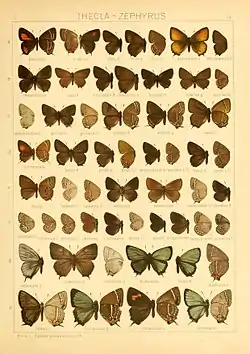Satyrium herzi
Satyrium herzi is a butterfly of the subfamily Lycaeninae. It was described by Johann Heinrich Fixsen in 1887. It is found in the Russian Far East (Amur, Ussuri), north-eastern China and Korea.[2]
| Satyrium herzi | |
|---|---|
 | |
| 73d in Adalbert Seitz' Die Großschmetterlinge der Erde | |
| Scientific classification | |
| Kingdom: | Animalia |
| Phylum: | Arthropoda |
| Class: | Insecta |
| Order: | Lepidoptera |
| Family: | Lycaenidae |
| Genus: | Satyrium |
| Species: | S. herzi |
| Binomial name | |
| Satyrium herzi | |
| Synonyms | |
| |
The larvae feed on Malus mandschurica, Malus baccata and Malus pallasiana.
Description from Seitz
T. herzi Fixs. (= phellodendri Stgr. i. I.) (73d). Hindwing tailless, two teeth above the anal angle. Upperside unicolorous, the male with a pale scent-spot. Underside traversed by two rows of black-centred ocelli, there being a similar spot at the apex of the cell. Hindwing beneath with small red anal band. Fixsen has proposed the names ab. fulva and ab. fulvofenestrata for specimens with a more or less large futvo- yellow discal patch on the forewing. — Amurland, Corea. Larva velvety, uniformly dark green, beneath more bluish green, with the head glossy black. In June adult on Pyrus. Pupa light green, with a brownish violet saddle-spot (Graeser). The butterfly appears in July, flying particularly about the twigs of Phellodendron amurense.[3]
References
- Fixsen, 1887 Lepidoptera aus Korea in Romanoff, Mém. Lépid. 3: 233-356, pl. 13-15
- Savela, Markku (March 21, 2019). "Satyrium herzi (Fixsen, 1887)". Lepidoptera and Some Other Life Forms. Retrieved February 6, 2020.
- Seitz, A. ed. Band 1: Abt. 1, Die Großschmetterlinge des palaearktischen Faunengebietes, Die palaearktischen Tagfalter, 1909, 379 Seiten, mit 89 kolorierten Tafeln (3470 Figuren)
- "Satyrium herzi (Fixsen, 1887)". Insecta.pro. Retrieved February 6, 2020.